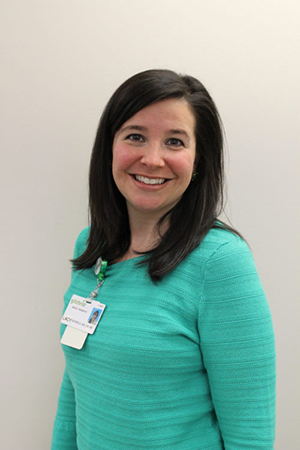“Someday, We’ll Meet Again”
Honoring a patient’s choice to share their experience with others.

It comes as no surprise that, when we hear music—good music, familiar music, music that is relatable, we often find ourselves singing along or tapping our feet, perhaps even being curious enough to locate the source of the music. This “pied-piper” effect is something that when providing music therapy, I have always been keenly aware of and often struggled with as it relates to my practice. From my early career when I worked in non-private patient rooms, to later in an open-door classroom setting, and now at Gilchrist, providing music therapy in the community, I have come to view the “luring” effect of music in a very different way.
While every music therapist understands that what we do is therapy, and therefore, should be private and confidential, working with a patient in a quiet, personal, undisturbed space is not always possible or realistic. Hospital rooms are not always private and interruptions by medical staff are necessary. Classrooms for children with special needs often have multiple staff and other therapists. And both settings are guaranteed to have the curious onlooker who passes by as they hear the music flowing.
Sessions with Gilchrist are no different. In residential community care, we provide music therapy to patients who often have a roommate or a room that is not conducive to therapy. In home care, patients often have visitors and caregivers present during music therapy.
Sharing the Music Therapy Experience
I used to be rather rigid about where I provided music therapy and would often spend time trying to overcome hurdles so that I could work with my patient in a quiet, undisturbed space—away from other residents or those who may spontaneously break into song upon hearing a favorite tune. But over the years I have come to find that in most circumstances, the inclusion of others during music therapy can enhance the patients’ experiences.
Four years ago, I worked with a patient who lived in one of our partner facilities. After spending a few visits getting to know her, she asked me one day, “Why is this just for me? Why can’t everyone enjoy the music? You should sing so everyone can hear you!”
I explained to her why she had been referred for music therapy and how it could benefit her. Still, wanted the music to be shared. Because she was bed-bound, I wasn’t exactly sure how to honor her request, so we started by leaving her door wide open so that others in nearby rooms could hear.
She then started sending me to knock on the doors of her friends, inviting them to come hear the music. We started with one or two other residents joining in, but eventually so many residents gathered that we had to start “clearing a path” to the door. Staff at the facility even went to alert other residents when music therapy was about to begin.
At first, I was anxious and hesitant about sharing a patient’s music therapy experience with others. I couldn’t help but think, What if I can’t keep the focus on my patient? What if someone else requests a song she doesn’t like or has a very emotional response that I can’t address? What if she becomes upset or anxious and I have to change the music to address this, but it isn’t something that others want to hear?
Letting the Patient Lead
As I sat back and gave my patient control of what was happening, I soon realized that she was no longer focusing on things that troubled her that she had no control over. She wasn’t frowning, and her face had brightened. She was laughing, even rolling her eyes at some of the “attention-seeking” behavior of others who were singing out loud. Except for playing the piano, I didn’t have to “lift a finger.”
My patient asked everyone gathered to choose a song and then asked me to play and sing. This small group would talk together about what the songs meant to them. At times, a tear would be shed, but this expression was met with empathy and kindness and often encouraged the group to specifically share about the loss of their spouses which all had experienced.
I began to associate each member of the group with a song, that one song, that they always requested. And even when someone was missing, we still played and sang their special request. After my patient died, I lost track of most of these special women, occasionally passing by one of them in the hallway when I happened to be visiting.
Two years ago, I received a referral at the same community, and when I approached the patient’s room, I quickly realized that I already knew her well. I glanced across the hallway, envisioning my special group from years past. As I walked into my patient’s room and greeted her, she said, “Oh goody! I knew you’d be back someday!”
We picked up right where we left off. She immediately requested, “Somewhere, My Love,” —the song I always associated with her— and as I played and sang, for a moment, I could hear the laughter and singing echoing across the hall as it once had. I knew her favorite songs and why she chose them.
Interestingly, as this patient faced her own terminal diagnosis and desire to pursue hospice, it was the work we had already done together that allowed me to easily bring up this topic. We would reminisced by singing everyone’s favorite songs and recalling each member of the group. I realized that my patient had never fully mourned the passing of her neighbor and the loss of this special group, and so we did this, years later, using the music.
Honoring the Patient’s Wishes
Over the past two years, my patient’s choice of music has not really changed from all those years ago. And in honoring her neighbor’s choice to share the music, anytime someone knocks on the door, she invites them in to listen for a few minutes or choose a favorite song to hear.
I realize now that sharing music can be the therapy. When patients ask me if I will play in a common area so that others may hear, I do my best to honor this wish. I think a lot of the time, by giving the patient a choice, we are instilling in them not only some control but also, even in their most vulnerable, terminal state, the ability to do something, give something, share something.
Having worked for Gilchrist for seven years, it seems all too common now that I come across family members and friends of those I cared for who are now seeking care. While I am not always quick to recall a face or name, it is the music that once was shared that creates an immediate connection for me. I am so grateful to those who, at a time when they should’ve only been thinking about themselves, thought about how much joy and meaning could be brought to others with “their” music. And while my patient hears the words of her favorite song and associates them with the loss of her spouse, I can’t help but hear them and think of her:
“Somewhere, my love there will be songs to sing
Although the snow covers the hope of spring
Somewhere a hill blossoms in green and gold
And there are dreams all that your heart can hold.
Someday we’ll meet again my love
Someday whenever the spring breaks through
You’ll come to me out of the long ago
Warm as the wind, soft as the kiss of snow
Till then my sweet, think of me now and then
God speed my love ‘til you are mine again.”
To learn more about music therapy at Gilchrist, visit: gilchristcares.org/musictherapy.


